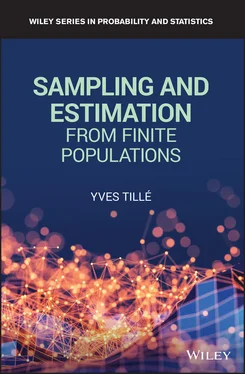Yves Tille - Sampling and Estimation from Finite Populations
Здесь есть возможность читать онлайн «Yves Tille - Sampling and Estimation from Finite Populations» — ознакомительный отрывок электронной книги совершенно бесплатно, а после прочтения отрывка купить полную версию. В некоторых случаях можно слушать аудио, скачать через торрент в формате fb2 и присутствует краткое содержание. Жанр: unrecognised, на английском языке. Описание произведения, (предисловие) а так же отзывы посетителей доступны на портале библиотеки ЛибКат.
- Название:Sampling and Estimation from Finite Populations
- Автор:
- Жанр:
- Год:неизвестен
- ISBN:нет данных
- Рейтинг книги:4 / 5. Голосов: 1
-
Избранное:Добавить в избранное
- Отзывы:
-
Ваша оценка:
Sampling and Estimation from Finite Populations: краткое содержание, описание и аннотация
Предлагаем к чтению аннотацию, описание, краткое содержание или предисловие (зависит от того, что написал сам автор книги «Sampling and Estimation from Finite Populations»). Если вы не нашли необходимую информацию о книге — напишите в комментариях, мы постараемся отыскать её.
Sampling and Estimation from Finite Populations Provides an up-to-date review of the theory of sampling Discusses the foundation of inference in survey sampling, in particular, the model-based and design-based frameworks Reviews the problems of application of the theory into practice Also deals with the treatment of non sampling errors
is an excellent book for methodologists and researchers in survey agencies and advanced undergraduate and graduate students in social science, statistics, and survey courses.



 , where
, where  represents the number of times that unit
represents the number of times that unit  is selected in the sample. The
is selected in the sample. The  can therefore take any non‐negative integer value.
can therefore take any non‐negative integer value. is therefore a positive discrete random vector. The value
is therefore a positive discrete random vector. The value  is the expectation under the design of the number of times that unit
is the expectation under the design of the number of times that unit  is selected. We also write
is selected. We also write  ,
,  , and
, and  . The expectation
. The expectation  since
since  can take values larger than 1. We assume that
can take values larger than 1. We assume that  for all
for all  . Under this assumption, the Hansen–Hurwitz (HH) estimator is
. Under this assumption, the Hansen–Hurwitz (HH) estimator is
 (Hansen & Hurwitz, 1949). The demonstration is the same as for Result 2.4.
(Hansen & Hurwitz, 1949). The demonstration is the same as for Result 2.4.
 for all
for all  , this variance can be unbiasedly estimated by
, this variance can be unbiasedly estimated by

 from
from  to
to  :
:
 , the first‐order inclusion probability
, the first‐order inclusion probability
 , the second‐order inclusion probability
, the second‐order inclusion probability













